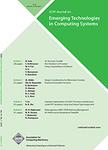版权所有:内蒙古大学图书馆 技术提供:维普资讯• 智图
内蒙古自治区呼和浩特市赛罕区大学西街235号 邮编: 010021

作者机构:Karlsruhe Inst Technol Chair Dependable Nano Comp Haid & Neu Str 7 D-76131 Karlsruhe Baden Wurttembe Germany Chair Pervas Comp Syst TECO Vincenz Priessnitz Str 1 D-76131 Karlsruhe Baden Wurttembe Germany
出 版 物:《ACM JOURNAL ON EMERGING TECHNOLOGIES IN COMPUTING SYSTEMS》 (ACM计算系统新兴技术杂志)
年 卷 期:2024年第20卷第1期
页 面:1-20页
核心收录:
学科分类:0808[工学-电气工程] 08[工学] 0805[工学-材料科学与工程(可授工学、理学学位)] 0812[工学-计算机科学与技术(可授工学、理学学位)]
主 题:Computation-in-memory STT-MRAM neuromorphic computing variations robust neural network acceleration
摘 要:Neural Networks (NN) can be efficiently accelerated in a neuromorphic fabric based on emerging resistive non-volatile memories (NVM), such as Spin Transfer Torque MagneticRAM(STT-MRAM). Compared to other NVM technologies, STT-MRAM offers many benefits, such as fast switching, high endurance, and CMOS process compatibility. However, due to its low ON/OFF-ratio, process variations and runtime temperature fluctuations can lead to miss-quantizing the sensed current and, in turn, degradation of inference accuracy. In this article, we analyze the impact of the sensed accumulated current variation on the inference accuracy in Binary NNs and propose a design-time reference current generation method to improve the robustness of the implemented NN under different temperature and process variation scenarios (up to 125. C). Our proposed method is robust to both process and temperature variations. The proposed method improves the accuracy of NN inference by up to 20.51% on the MNIST, Fashion-MNIST, and CIFAR-10 benchmark datasets in the presence of process and temperature variations without additional runtime hardware overhead compared to existing solutions.